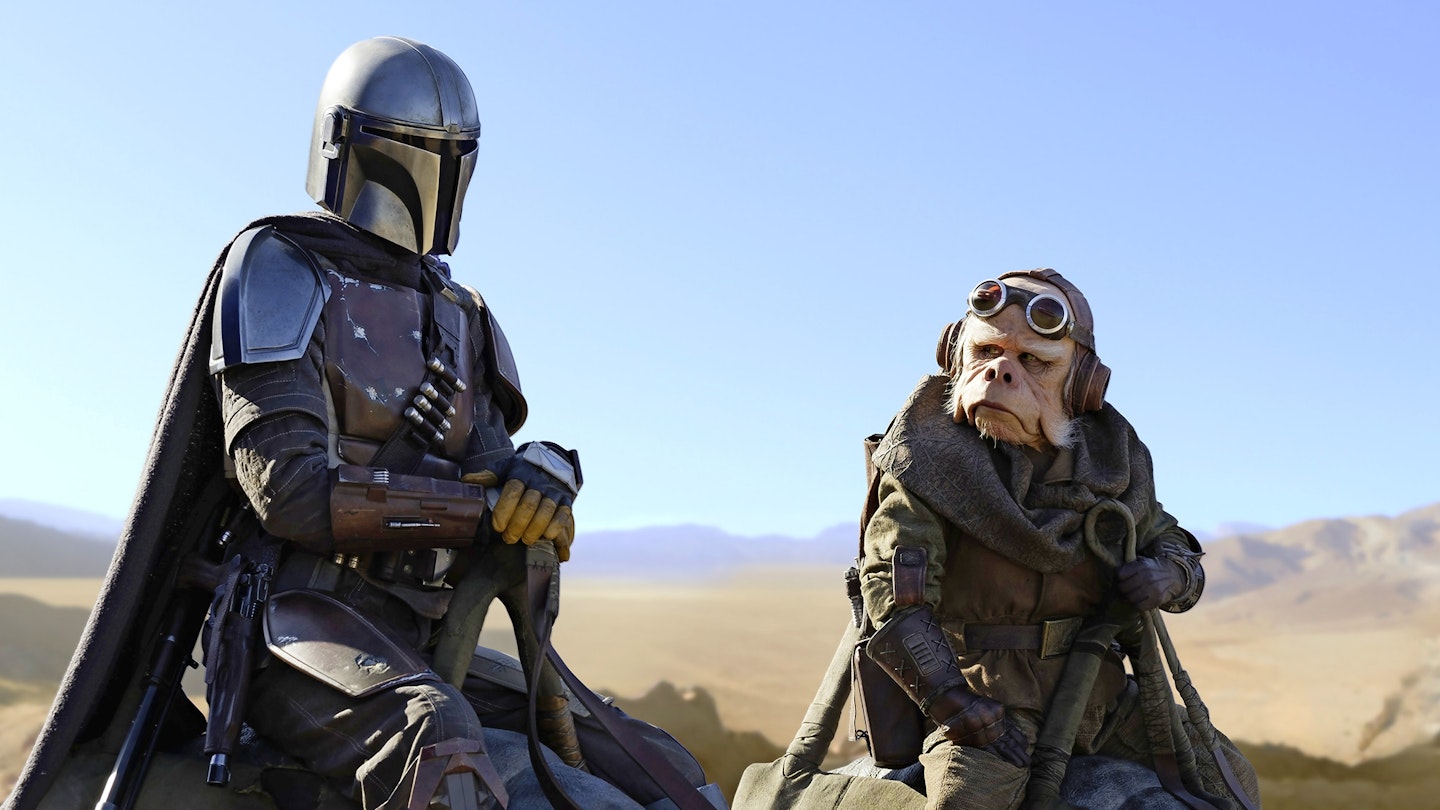It’s been a full four months since Disney+ and its flagship show, The Mandalorian, launched in the US. Four months during which Baby Yoda grew into an internet phenomenon, and the Mandalorian mantra, “This is the way,” became the mic drop at the end of every third Twitter exchange. This month UK audiences are finally able to get in on the action, although coming off the operatic battles and galaxy-ending stakes of The Rise Of Skywalker, Star Wars’ first live-action series might at first feel underwhelming.
We’re introduced to ‘Mando’ (Pascal) at a seedy watering hole at the arse-end of space. After confronting his target (“I can take you in warm, or I can take you in cold”), he picks up his bounty and goes on his way. It’s the beginning of a small story, intimately told, and a radical gear-shift from the propulsive events of the movies. But the change in tone and scale is a welcome one. Showrunner Jon Favreau allows us to wallow in the texture of George Lucas’ galaxy as never before: the grit and grime of his ‘used universe’ placed front and centre in a way it hasn’t been since Luke and Ben first stepped into Mos Eisley’s cantina.

It’s to Sergio Leone rather than Lucas that The Mandalorian owes much of its debt. With a nameless gunman (Mando’s moniker is revealed in a later episode but still goes unused) and dusty, desert frontier towns, the show deliberately riffs on the Dollars trilogy; its laconic anti-hero walking into town — weapons clanking off armour like the jink of spurs — and leaving a trail of bodies in his wake. The climax of the first episode in particular could be lifted from any one of a dozen Spaghetti Westerns, as gunmen on rooftops fall to Mando’s quickdraw — plummeting from perches to a strangled Wilhelm scream. Ludwig Göransson’s Morricone-inspired score — with distinctive flute motif — only serves to enhance this effect.
For the bulk of the show’s eight-episode run, the Western formula sets The Mandalorian’s agenda: bounties are served, heists staged and battles fought, allowing for beautifully crafted single episodes (ranging from 30 to 50 minutes each), from the defence of a village from bandits, to a standout, almost dialogue-free instalment in which Mando has to deal with a gaggle of troublesome Jawas. The main arc simmers in the background, only coming to the fore as the season draws towards its eventual close, but rather than deprive the show of momentum, the pacing serves to ground us in the lawless, frontier mentality of the world in which Mando exists. It also allows us to get to know the show’s laconic star. Like Boba Fett, he’s striking in his distinctive armour, but unlike the cipher of Lucas’ original films (a character whose popularity stems entirely from a badass aesthetic), the substance of Mando’s character is gradually pieced together by his actions, as well as shadows of the past that return to haunt him.
Jon Favreau allows us to wallow in the texture of George Lucas’ galaxy as never before.
All we know early on is that he never removes his helmet, dislikes droids, and has a reputation that precedes him — like an intergalactic John Wick, clad in Beskar steel. Mando is a man of action, and despite remaining encased in armour, Pascal gifts the character a distinctive physicality that more than compensates for the scarcity of dialogue.
Fittingly given its Western roots, the show’s supporting characters are similar variations on broad archetypes, from Carl Weathers’ grizzled bounty hunter boss to Gina Carano’s veteran Rebel shock trooper. Precious few are even introduced by name, but each has a distinct flavour, Nick Nolte’s gruff Ugnaught dropping pearls of wisdom (“I have spoken”) and Taika Waititi’s homicidal droid bringing light comic relief. It’s Herzog’s glorious turn as The Client that proves the standout early on, though, the Grizzly Man director chewing up scenery like a Death Star trash compactor.

And then there’s Baby Yoda — or The Child, to give him his official title — the first episode’s big reveal and arguably the secret to the show’s success. As Mando’s ward, The Child not only provides the show with an iconic mascot and figurehead, but lends an urgency and emotional core to the storytelling, offsetting the pervasive nihilism and morally dubious protagonist to give The Mandalorian real heart. That and being almost unbearably cute. The mystery of The Child’s origins and the quest to keep him safe establish themselves as the backbone of the series, and it’s this masterstroke by Favreau that has ensured the show a life well beyond the Star Wars die-hards.
With its more personal, low-key feel, The Mandalorian may not have the epic scope of its cinematic counterparts, but this is a sumptuously produced, painstakingly crafted show that successfully demonstrates Star Wars’ potential beyond the silver screen. As Lucasfilm reassesses the franchise’s future post Episode IX, they’d do well to stop, listen and learn what The Mandalorian has to teach. This is the way.








